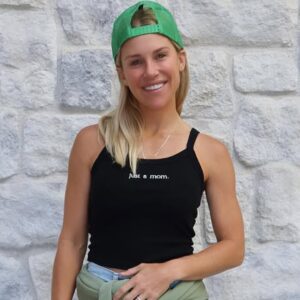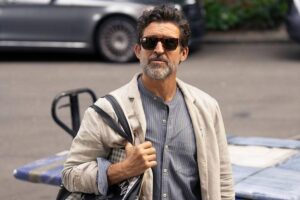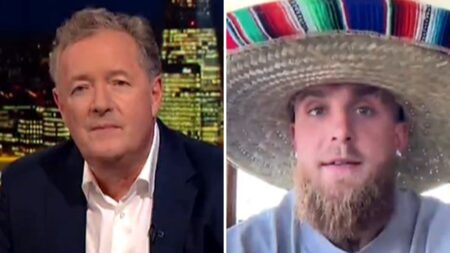SPOILER ALERT: This article contains spoilers for “The Big Pump,” Season 2, Episode 10 of “Poker Face,” now streaming on Peacock.
The last time “Poker Face” fans saw Clea DuVall, she played Charlie’s (Natasha Lyonne) estranged sister in the Season 1 finale, which left the future of their relationship uncertain. But in this week’s episode of Season 2, the “Happiest Season” director returns behind the camera for an adrenaline-filled murder mystery set in a gym.
“My approach in working with actors really comes from having the privilege to work with as many incredible directors as I have. I’ve seen so many brilliant, talented directors do things very well, and I’ve also seen less experienced directors do things that didn’t work as well,” DuVall tells Variety. “I can sort of pick and choose what I find helpful, and bring that to the table when working with actors.”
Shot over the course of 10 days, “The Big Pump” follows fitness trainer Brick (Method Man), who winds up slicing Rodney’s (Jason Ritter) neck by throwing a discus, commonly used in track and field events, after Rodney discovers Brick’s breast milk operation is pumping up the gym regulars. Naturally, Charlie begins nosing around with the encouragement of her new friend, Alex (Patti Harrison), and discovers there’s more to the sweaty gym than lets on.
Jason Ritter as Rodney
Courtesy of Ralph Bavaro/PEACOCK
Charlie gets to slow down a little this episode after meeting the lonely Alex, and finds herself more behind than usual when looking into the mystery. “It’s such a luxury for Charlie to have someone she can really spend time with, and get to know. It’s not just that transient nature,” DuVall says. “I think it’s really something new for the show. Being able to take a different kind of quiet moment was really fun.”
Below, DuVall breaks down pulling off that gruesome murder, reuniting with Natasha Lyonne and the continued legacy of queer classic “But I’m a Cheerleader,” which is celebrating its 25th anniversary this year.
Following your guest star role in Season 1, what was it like returning to the world of the show, but now as director?
This is my first time being a guest director, but you always have that sort of first day of school feeling, and because I had already been there and knew some of the people, it really just felt so comfortable. Everyone was so warm and welcoming, and it was just such a nice environment.
Stepping into a show that not only has rotating guest stars but rotating directors, how did you approach bringing your own voice while also continuing what’s already been established in the episodes prior?
It’s a whole new kind of creativity. Obviously, “Poker Face” is so distinct, but because you’re basically making a mini movie every week, you really can have more ownership in a very exciting way. It just makes it really inspiring, and the crew is so incredible. They’re creating these whole new worlds every week and doing it at the top of their game.
What was your approach to filming the fight choreography for the actual murder scene?
Rian Johnson and showrunner Tony Tost had given me some references, and working with the stunt coordinator was so amazing. We were lucky enough to get to spend a lot of time in the space so we could really tailor it to the set. I think it just made it really come alive and really fun. But brutal. What a brutal death!

Laith Wallschleger as Kevin, Cliff “Method Man” Smith as Brick
Courtesy of Ralph BRalph Bavaro/PEACOCKavaro/PEACOCK
I know! I don’t know if that’s exactly how it was scripted, but obviously the big thing every episode is wondering how the murder is going to happen. How did you want to visualize that and bring your flair to it?
That was scripted. We knew how the fight ended, so we worked backwards from there with our stunt coordinator and team to find the most exciting and unexpected ways to get to that very brutal ending.
When we first see Charlie this episode, there’s a little tilt with the camera. What was the inspiration behind that? It reminded me of “Russian Doll” a little.
Because she starts out with that crick, I wanted something to represent that. It just felt like this fun little moment of going from “Everything is normal” to “Everything kind of shifts slightly.” Speaking as someone who has had a crick in my head many times, it does feel like the whole world is at an axis. It just seemed like a fun way to play with that.
There’s also the dolly zoom that happens later on when Charlie has that big moment of epiphany.
The DP, Jaron Presant, and I talked a lot about that moment, because the space we were in was pretty cramped. You need space to be able to pull that off, so we worked really hard to find a way to do it where it felt organic. And I’m really happy with how it turned out.
Speaking of that space, the gym setting in this episode is so much fun, and it feels like something new for the show. How did you find the right location?
Judy Rhee, the production designer, is a genius, and I don’t understand how she pulls off creating all new worlds every episode. She’s just astounding, and I worked really closely with her to create the perfect setting for this. We went to so many gyms and just found one that felt like more of a blank canvas. We were able to build the world more from the ground up, rather than just finding a gym that already existed. In the gym, we also had a lot of space, and that’s part of why we chose that location. We had a lot of room to play.
With the macho men, were there specific things you wanted to poke fun at? I just thought that was so funny.
Method Man, obviously, was so much fun to work with, and so game. He really brought so much to it — I didn’t know he was so funny. It just felt like everybody showed up and was game to be a little silly. My approach was not to make fun of people, but more, like, “Let’s take this as seriously as possible.” That is funnier to me, taking some of these moments as seriously as we could when, ultimately, it’s just about working out.

Natasha Lyonne as Charlie Cale, Clea DuVall as Emily Cale
Courtesy of Peacock
Is Charlie’s sister a role you would be open to reprising in a potential Season 3? Or are you hoping to return to direct more episodes?
I would do anything Natasha and Rian asked me to do.
That dynamic with them must be so much fun on set.
It’s awesome. I love working with one of my best friends, and Rian is so brilliant and cool. I went to New York a little early, because he was directing the episode before mine, and I wanted to spend some time just watching him on set. He’s obviously brilliant and an incredible director and writer, but he’s also a phenomenal leader who sets this wonderful tone on set that feels like everything is under control, and yet he is not controlling. He just knows what he wants; he’s calm and specific, and he allows everyone to add their own creativity. Yet he’s still guiding the ship.

Courtesy of Ralph Bavaro/PEACOCK
This marks just the latest collaboration between you and Natasha since “But I’m a Cheerleader.” You’ve acted alongside Natasha several times. What is it like directing her?
Natasha was also in my first movie, “The Intervention,” so we had worked together as actor and director and had a little bit of a shorthand in that regard. Obviously, “Poker Face” is so different because it’s all her, she does so much and she works so hard. It was really fun!
Looking back at “But I’m a Cheerleader,” is there anything about the way Jamie Babbit directed that movie that influenced your directing style or the things that are important to you when working with actors?
Jamie is a director who really pushed me in a way that few directors have, and I really was so grateful for that because when I was younger, I was so much more in my shell and quieter, smaller. She really pushed me out of my comfort zone, and that was important for me. It really inspired me to make sure I’m doing whatever I can with my actors to make them feel comfortable enough where they can take swings or maybe go a little bigger than they want to. Even if you take a risk and it’s not good and won’t get used, I only want them to feel supported.
“But I’m a Cheerleader” is turning 25 this year, which is super exciting. Could you speak to the continued impact that film has, especially in the place the world is right now with queer rights being taken away?
It’s the thing that I get approached about the most, and it’s so special that a movie so special to me is still having just as much of an impact as it always has, if not more so. And to see young people discovering it now — that doesn’t happen very often. You don’t make things that are that significant for people in a way that really changes their life and gives them courage, makes them feel less alone. It’s not common, so I know how lucky I am that I got to make that movie and that it’s still resonating 25 years later.

“But I’m a Cheerleader”
©Lions Gate/Courtesy Everett Co
I know that you’ve directed some queer rom-coms of your own with “Happiest Season,” how did “But I’m a Cheerleader” influence the kind of movies you’ve directed with queer characters?
It definitely makes me think about the stories I want to tell. Because there are a lot of different kinds of movies, and they all have different values. I’m personally someone who really enjoys things that are there just to entertain me, but a movie like “But I’m a Cheerleader” is so entertaining but also so important. To be able to do both is not easy, but my involvement in that movie has definitely made me strive to find that combination in the work I do.
This interview has been edited and condensed.
Read the full article here








